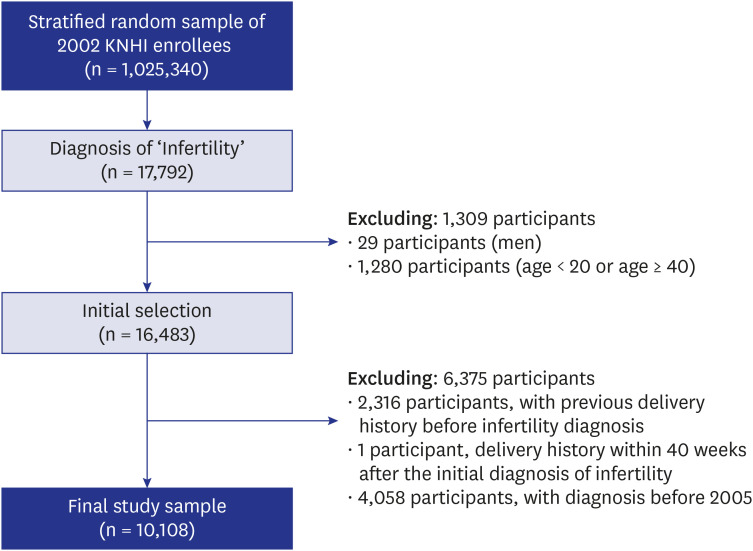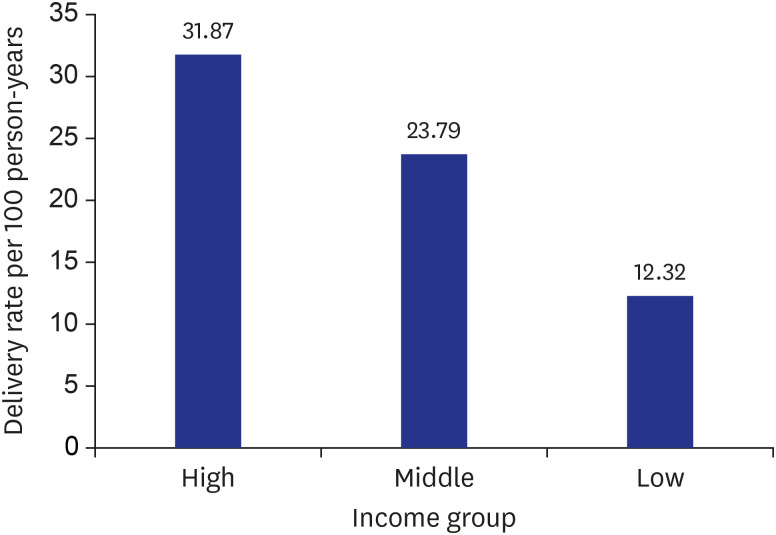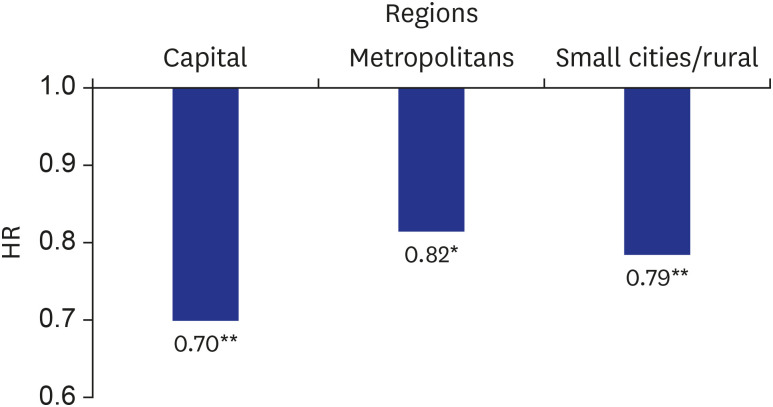J Korean Med Sci.
2020 Oct;35(39):e341. 10.3346/jkms.2020.35.e341.
Socioeconomic Status and Successful Delivery after an Infertility Diagnosis: a Nationwide Health Insurance Cohort Study in Korea Conducted from 2005 to 2013
- Affiliations
-
- 1Department of Preventive Medicine, Ajou University School of Medicine, Suwon, Korea
- 2Department of Policy Analysis and Management, College of Human Ecology, Cornell University, Ithaca, NY, USA
- 3Department of Preventive Medicine, Yonsei University College of Medicine, Seoul, Korea
- 4Institute of Health Service Research, Yonsei University, Seoul, Korea
- 5Department of Hospital Management, Graduate School of Public Health, Yonsei University, Seoul, Korea
- 6Department of Public Health Science, Graduate School, Korea University, Seoul, Korea
- KMID: 2507608
- DOI: http://doi.org/10.3346/jkms.2020.35.e341
Abstract
- Background
The global disease burden of infertility is rising and accessibility to infertility treatments and assisted reproduction is a challenging issue. Therefore, we investigated characteristics of successful delivery after an infertility diagnosis among infertile women.
Methods
We designed a retrospective cohort study with the main outcome measure of a delivery medical record after the initial diagnosis of infertility. A total of 10,108 women patients who were diagnosed with infertility between 2005 to 2013 in the National Health Insurance Cooperation Cohort Database of Korea were enrolled. The adjusted hazard ratios (HRs) and 95% confidence intervals (CIs) for subsequent delivery were estimated by applying a Cox proportional-hazard regression model.
Results
Approximately 55% of infertile women who reported infertility had a delivery eventually. Infertile women who are aged between 30 to 39 (HR, 0.80; 95% CI, 0.75–0.84), in low income level (HR, 0.77; 95% CI, 0.71–0.84), or diagnosed with diabetes (HR, 0.76; 95% CI, 0.60–0.96) were less likely to report a delivery.
Conclusion
These findings highlight demographic, socioeconomic, and medical characteristics of reporting a consequent delivery. Although many previous articles reported an association between socioeconomic status and receiving medical evaluation, there were few studies regarding successful delivery after an infertility diagnosis across socioeconomic status. Thus, the maintaining of support for low socioeconomic status infertile women and their family should be considered after the infertility diagnosis in aspects of financial and social approaches.
Keyword
Figure
Cited by 1 articles
-
Socioeconomic Factors and Abortive Outcomes of Clinical Pregnancy After Embryo Transfer in the Setting of Universal Health Insurance Coverage of IVF
Jee Hyun Kim, Seyoung Kim, Ki-Jin Ryu, Hyuntae Park, Yong-Jin Kim, Seung-Ah Choe
J Korean Med Sci. 2023;38(38):e293. doi: 10.3346/jkms.2023.38.e293.
Reference
-
1. Boivin J, Bunting L, Collins JA, Nygren KG. International estimates of infertility prevalence and treatment-seeking: potential need and demand for infertility medical care. Hum Reprod. 2007; 22(6):1506–1512. PMID: 17376819.
Article2. Vayena E, Rowe PJ, Griffin PD. Current Practices and Controversies in Assisted Reproduction: Report of a WHO Meeting on “Medical, Ethical and Social Aspects of Assisted Reproduction”. Geneva: World Health Organization;2002.3. Ombelet W, Cooke I, Dyer S, Serour G, Devroey P. Infertility and the provision of infertility medical services in developing countries. Hum Reprod Update. 2008; 14(6):605–621. PMID: 18820005.
Article4. Cousineau TM, Domar AD. Psychological impact of infertility. Best Pract Res Clin Obstet Gynaecol. 2007; 21(2):293–308. PMID: 17241818.
Article5. OECD. Fertility rates. Total, children/woman, 1970–2017. Updated 2019. Accessed July 4, 2019. https://data.oecd.org/pop/fertility-rates.htm.6. Eun KS. Lowest-low fertility in the Republic of Korea: causes, consequences and policy responses. Asia Pac Popul J. 2007; 22(2):51–72.
Article7. Ma L. Female labour force participation and second birth rates in South Korea. J Popul Res (Canberra). 2016; 33(2):173–195.
Article8. Hwang N, Lee S, Chang I. The Result and Assessment of Supporting Program for Parents Couples with Infertility in 2016. Sejong: Ministry of Health and Welfare, Korea Institute for Health and Social Affairs;2017.9. Lee J, Lee JS, Park SH, Shin SA, Kim K. Cohort profile: the National Health Insurance Service-National Sample Cohort (NHIS-NSC), South Korea. Int J Epidemiol. 2017; 46(2):e15. PMID: 26822938.
Article10. Shin YJ. Policy context of the poor progress of the pro-poor policy: a case study on the medical-aid policy during Kim Dae-jung's government (1998–2002) in the Republic of Korea. Health Policy. 2006; 78(2-3):209–223. PMID: 16289428.
Article11. National Health Insurance Service. National Health Insurance Service Statistical Yearbook. Wonju: National Health Insurance Service;2012.12. Howell EA, Zeitlin J, Hebert PL, Balbierz A, Egorova N. Association between hospital-level obstetric quality indicators and maternal and neonatal morbidity. JAMA. 2014; 312(15):1531–1541. PMID: 25321908.
Article13. Farland LV, Collier AY, Correia KF, Grodstein F, Chavarro JE, Rich-Edwards J, et al. Who receives a medical evaluation for infertility in the United States? Fertil Steril. 2016; 105(5):1274–1280. PMID: 26785253.
Article14. Eisenberg ML, Li S, Cullen MR, Baker LC. Increased risk of incident chronic medical conditions in infertile men: analysis of United States claims data. Fertil Steril. 2016; 105(3):629–636. PMID: 26674559.
Article15. Kessler LM, Craig BM, Plosker SM, Reed DR, Quinn GP. Infertility evaluation and treatment among women in the United States. Fertil Steril. 2013; 100(4):1025–1032. PMID: 23849845.
Article16. Morris M, Oakley L, Maconochie N, Doyle P. An investigation of social inequalities in help-seeking and use of health services for fertility problems in a population-based sample of UK women. Hum Fertil (Camb). 2011; 14(1):16–22. PMID: 21121703.
Article17. Nahar P. The link between infertility and poverty: evidence from Bangladesh. Hum Fertil (Camb). 2012; 15(1):18–26. PMID: 22313219.
Article18. Chambers GM, Hoang VP, Illingworth PJ. Socioeconomic disparities in access to ART treatment and the differential impact of a policy that increased consumer costs. Hum Reprod. 2013; 28(11):3111–3117. PMID: 23906901.
Article19. Dhalwani NN, Fiaschi L, West J, Tata LJ. Occurrence of fertility problems presenting to primary care: population-level estimates of clinical burden and socioeconomic inequalities across the UK. Hum Reprod. 2013; 28(4):960–968. PMID: 23315065.
Article20. Smith JF, Eisenberg ML, Glidden D, Millstein SG, Cedars M, Walsh TJ, et al. Socioeconomic disparities in the use and success of fertility treatments: analysis of data from a prospective cohort in the United States. Fertil Steril. 2011; 96(1):95–101. PMID: 21616487.
Article21. Feldman E. Medical ethics the Japanese way. Hastings Cent Rep. 1985; 15(5):21–24. PMID: 4066301.
Article22. Bos HMW, van Rooij FB. The influence of social and cultural factors on infertility and new reproductive technologies. J Psychosom Obstet Gynaecol. 2007; 28(2):65–68. PMID: 17538813.
Article23. Lee DT, Ngai IS, Ng MM, Lok IH, Yip AS, Chung TK. Antenatal taboos among Chinese women in Hong Kong. Midwifery. 2009; 25(2):104–113. PMID: 17408821.
Article24. Inhorn MC. Making Muslim babies: IVF and gamete donation in Sunni versus Shi'a Islam. Cult Med Psychiatry. 2006; 30(4):427–450. PMID: 17051430.
Article25. Donkor ES, Sandall J. The impact of perceived stigma and mediating social factors on infertility-related stress among women seeking infertility treatment in Southern Ghana. Soc Sci Med. 2007; 65(8):1683–1694. PMID: 17673344.
Article26. Loke AY, Yu PL, Hayter M. Experiences of sub-fertility among Chinese couples in Hong Kong: a qualitative study. J Clin Nurs. 2012; 21(3-4):504–512. PMID: 21507092.
Article27. de Kok BC, Widdicombe S. ‘I really tried’: management of normative issues in accounts of responses to infertility. Soc Sci Med. 2008; 67(7):1083–1093. PMID: 18599172.28. Korean Statistical Information Service. Monthly income and percentage of households under deficit spending by quintile income group. Updated 2016. Accessed April 20, 2017. http://kosis.kr/statisticsList/statisticsList_01List.jsp?vwcd=MT_ZTITLE&parentId=C#SubCont.29. Dyer SJ, Sherwood K, McIntyre D, Ataguba JE. Catastrophic payment for assisted reproduction techniques with conventional ovarian stimulation in the public health sector of South Africa: frequency and coping strategies. Hum Reprod. 2013; 28(10):2755–2764. PMID: 23878180.
Article30. Xu K, Evans DB, Kawabata K, Zeramdini R, Klavus J, Murray CJ. Household catastrophic health expenditure: a multicountry analysis. Lancet. 2003; 362(9378):111–117. PMID: 12867110.
Article31. Fiscella K, Franks P, Gold MR, Clancy CM. Inequality in quality: addressing socioeconomic, racial, and ethnic disparities in health care. JAMA. 2000; 283(19):2579–2584. PMID: 10815125.32. Alter DA, Naylor CD, Austin P, Tu JV. Effects of socioeconomic status on access to invasive cardiac procedures and on mortality after acute myocardial infarction. N Engl J Med. 1999; 341(18):1359–1367. PMID: 10536129.
Article33. Hwang N, Chae S, Chang I. The Result and Assessment of Supporting Program for Parents Couples with Infertility in 2014. Sejong: Ministry of Health and Welfare, Korea Institute for Health and Social Affairs;2015.34. Del Boca D. The effect of child care and part time opportunities on participation and fertility decisions in Italy. J Popul Econ. 2002; 15(3):549–573.
Article35. Hank K, Kreyenfeld M. A multilevel analysis of child care and women's fertility decisions in Western Germany. J Marriage Fam. 2003; 65(3):584–596.
Article36. Brewster KL, Rindfuss RR. Fertility and women's employment in industrialized nations. Annu Rev Sociol. 2000; 26(1):271–296.
Article37. Räisänen S, Randell K, Nielsen HS, Gissler M, Kramer MR, Klemetti R, et al. Socioeconomic status affects the prevalence, but not the perinatal outcomes, of in vitro fertilization pregnancies. Hum Reprod. 2013; 28(11):3118–3125. PMID: 23892321.38. Korea Legislation Research Institute. Equal employment opportunity and work-family balance assistance act. Updated 2019. Accessed June 15, 2020. https://elaw.klri.re.kr/kor_service/lawView.do?hseq=51205&lang=ENG.
- Full Text Links
- Actions
-
Cited
- CITED
-
- Close
- Share
- Similar articles
-
- Association Between Socioeconomic Status and All-Cause Mortality After Breast Cancer Surgery: Nationwide Retrospective Cohort Study
- Analysis of Correlation between Thyroid Cancer Incidence and Socioeconomic Status Using 10-year Sample Cohort Database
- The Changes in the Trend of Thyroid Cancer incidence for Korean Population: Consecutive 10 Years Analysis (2004-2013)
- Incidence of varicella in children in Jeju-do, Korea, 2005–2016: age-period-cohort analysis
- Impact of Socioeconomic Status on 30-Day and 1-Year Mortalities after Intensive Care Unit Admission in South Korea: A Retrospective Cohort Study




